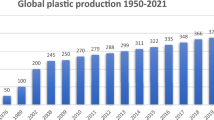Abstract
The presence of an alarm pheromone was demonstrated in the deutonymphal stage of the oribatid mite, Nothrus palustris (C. L. Koch). The active principle was identified as 3,7-dimethyl-(E)-2,6-octadienal, geranial, and was shown to be active at doses of 10–100 ng. This is the first such pheromone identified in oribatid mites.
Similar content being viewed by others
REFERENCES
Ayorinde, O., Wheeler, J. W., and Duffield, R. M. 1984. Synthesis of dehydrocineole, a new monoterpene form the acarid mite Caloglyphus rodriguezi (Arachnida: Acari). Tetrahedron lett. 25:3525–3528.
Howard, R. W., Kuwahara, Y., Suzuki, H., and Suzuki, T. 1988. Pheromone study on acarid mites XII. Characterization of the hydrocarbons and external gland morphology of the opisthonotal glands of six species of mites (Acari: Astigmata). Appl. Entomol, Zool. 23:58–66. eiKrivolutsy, D. A. (ed.) 1995. Oribatid Mites, Morphology, Development, Phylogeny, Ecology, Methods of Study, Model Species Nothrus palustris (C. L. Koch, 1839). Nauka Publishers, Moscow, 224 pp.
Kuwahara, Y. 1991. Pheromone study on astigmatid mites–alarm, aggregation and sex, pp. 43-52, in F. Dusbabek and V. Bukva (eds.). Modern Acarology, Vol. 1. SPB Academic Publishing, The Hague, and Academia, Prague.
Kuwahara, Y. 1995. Sex pheromone study of Caloglyphus sp. (Astigmata: Acaridae). Rep. Chem. Mat. R&D Found. 10:45–52 (in Japanese).
Kuwahara, Y. 1999. Chemical ecology in astigmatid mites, pp. 380–393, in T. Hidaka, Y. Matsumoto and K. Honda (eds.). Environmental Entomology: Behavior, Physilogy and Chemical Ecology. University of Tokyo Press, Tokyo (in Japanese).
Kuwahara, Y., Fukami, H., Ishii, S., Matsumoto, K., and Wada, Y. 1980. Pheromone study on acarid mite III. Citral: isolation and identification from four species of acarid mite, and its possible role. Jpn. J. Sani. Zool. 31:49–52.
Lebrun, P. 1970. Écologie et biologie de Nothrus palustrus (C. L. Koch, 1839) Acarien, Oribate: IV. Survivance-fécondité-action d'un prédateur. Acarologia 12:827–848.
Norton, R. A. 1994. Evolutionary aspects of oribatid mite life histories and consequences for the origin of the Astigmata, pp. 99–135, in M. A. Houck (ed.). Mites. Chapman & Hall, New York.
Raspotnig, G., Schuster, R., Krisper, G., Fauler, G., and Leis, H. J., 2002. Chemistry of the oil gland secretion of Collohmannia gigantea Sellnick, 1992 (Acari: Oribatida). Exp. Appl. Acarol. 2002 (in press).
Sakata, T. and Norton, R. A. 2001. Opisthonotal gland chemistry of early-derivative oribatid mites (Acari) and its relevance to systematic relationships of Astigmata. Int. J. Acarol. 27:281–292.
Sakata, T., Tagami, K., and Kuwahara, Y. 1995. Chemical ecology of oribatid mites I. Oil gland composition of Hydronothrus crispus. J. Acarol. Soc. Jpn. 4:69–75.
Sellnick, M. and Forsslund, H.-K. 1955. Die Camisiidae Schwedens (Acari, Oribat.). Ark. Zool. 8:473–530.
Shimano, S., Sakata, T., Mizutani, Y., Kuwahara, Y., and Aoki, J., 2001. An alarm pheromone function of the secretion from the nymphal stage of the oribatid mite Nothrus palustris (C. L. Koch) (Acari: Nothridae), pp. 250–252, in R. B. Holloday, D. E. Walter, H. C. Proctor, R. A. Norton and M. J. Colloff (eds.). Acarology: Proceedings of the 10th International Congress. CSIRO Publishing, Melbourne.
Author information
Authors and Affiliations
Corresponding author
Rights and permissions
About this article
Cite this article
Shimano, S., Sakata, T., Mizutani, Y. et al. Geranial: The Alarm Pheromone in the Nymphal Stage of the Oribatid Mite, Nothrus palustris . J Chem Ecol 28, 1831–1837 (2002). https://doi.org/10.1023/A:1020517319363
Issue Date:
DOI: https://doi.org/10.1023/A:1020517319363




